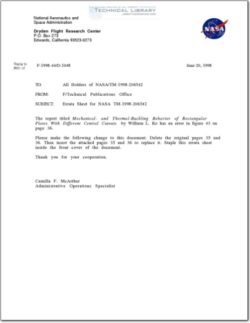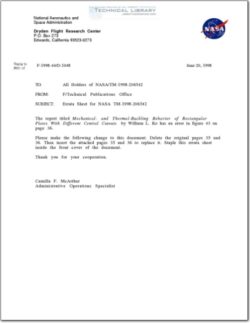NASA-TM-1998-206542

- Version
- 581 Downloads
- 932.01 KB File Size
- 1 File Count
- March 28, 2016 Create Date
- March 28, 2016 Last Updated
Mechanical and Thermal Buckling of Rectangular plates with Cutouts

In aerospace structures, cutouts are commonly used as access ports for mechanical and electrical
systems, or simply to reduce weight. Structural panels with cutouts often experience compressive loads
that are induced either mechanically or thermally, and can result in panel buckling. Thus, the buckling
behavior of those structural panels with cutouts must be fully understood in the structural design.
For an unperforated rectangular plate of finite extent (i.e., with finite length and finite width) under
uniform compression, the closed-form buckling solutions are easily obtained because the prebuckling
stress field is uniform everywhere in the plate. When a finite rectangular plate is perforated with a central
cutout (e.g., a circular or square hole), however, the buckling analysis becomes extremely cumbersome
because the cutout introduces a load-free boundary that causes the stress field in the perforated plate to be
nonuniform. Hence, the closed—form buckling solutions are practically unobtainable, and various approx—
imate methods had to be developed to analyze such perforated plates.
The buckling of flat square plates with central circular holes under in-plane edge compression has
been studied both theoretically and experimentally by various authors (refs. 1—12). The methods of theo—
retical analysis used by most of the past investigators (refs. 1—3, 5) were the Rayleigh-Ritz minimum
energy method and the Timoshenko method (ref. 13). However, except for Schlack (ref. 3) and Kawai
and Ohtsubo (ref. 5), the theoretical analysis methods used do not allow the boundary and loading condi—
tions to be precisely defined for larger hole sizes because the stress distributions of the infinite perforated
plate are used as the prebuckling stress solution for the finite perforated plate. Thus, most of the earlier
buckling solutions are limited to small hole sizes, and are not fit for studying the effects of different plate
boundary conditions on the buckling strengths of the finite plates with arbitrarily sized holes using those
approximate solutions.
| File | Action |
|---|---|
| NASA-TM-1998-206542 Mechanical and Thermal Buckling of Rectangular plates with Cutouts.pdf | Download |

Comment On This Post